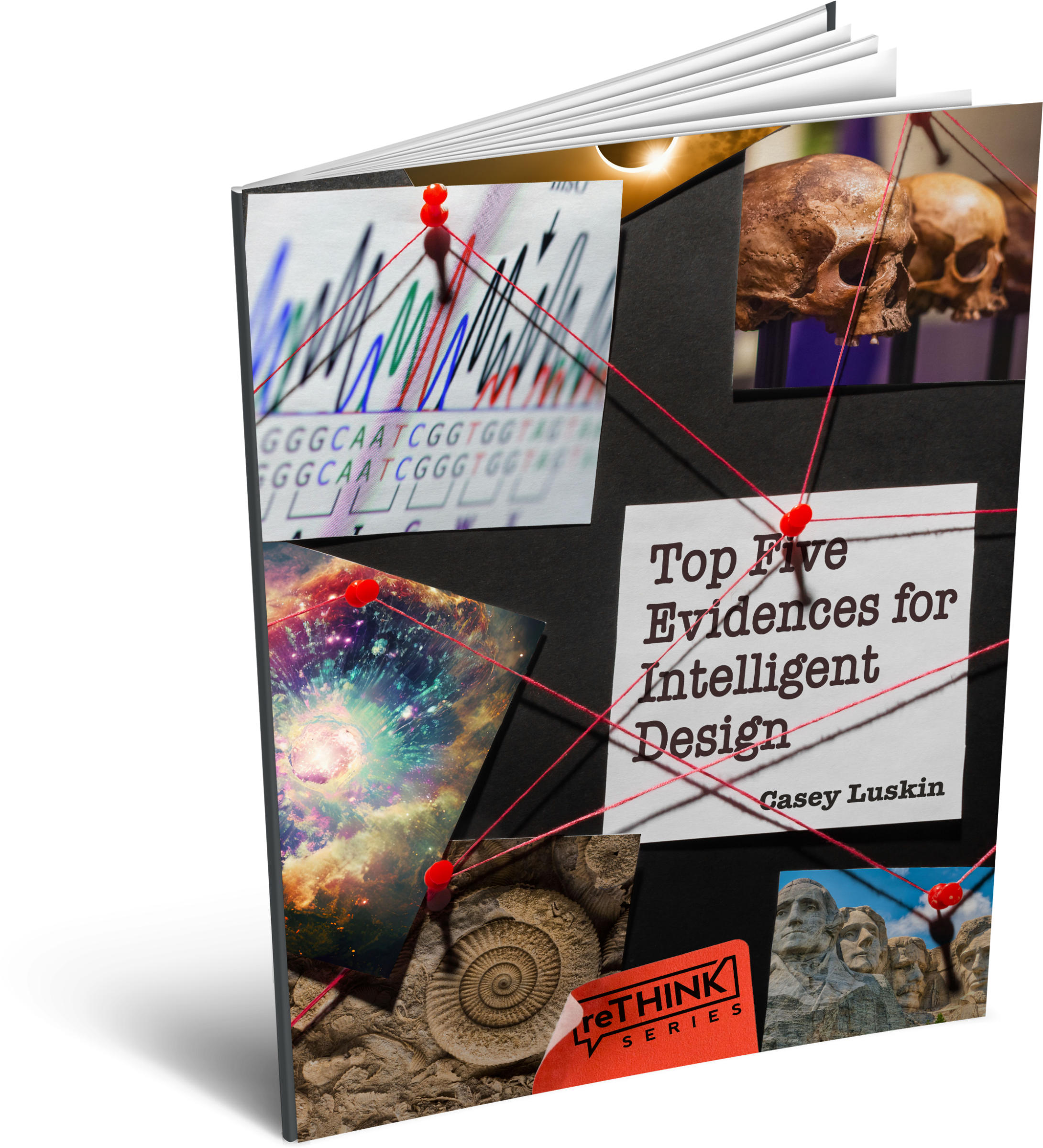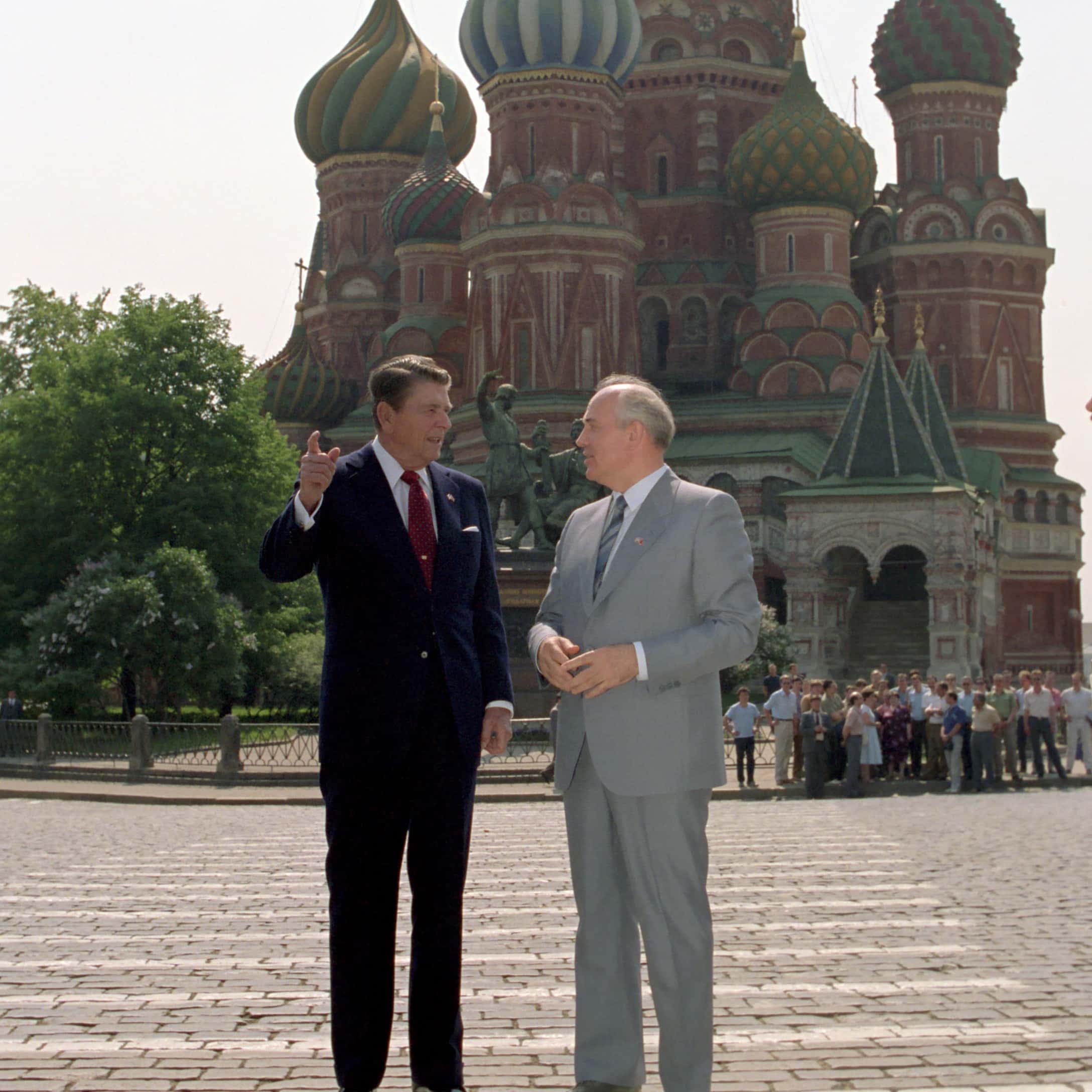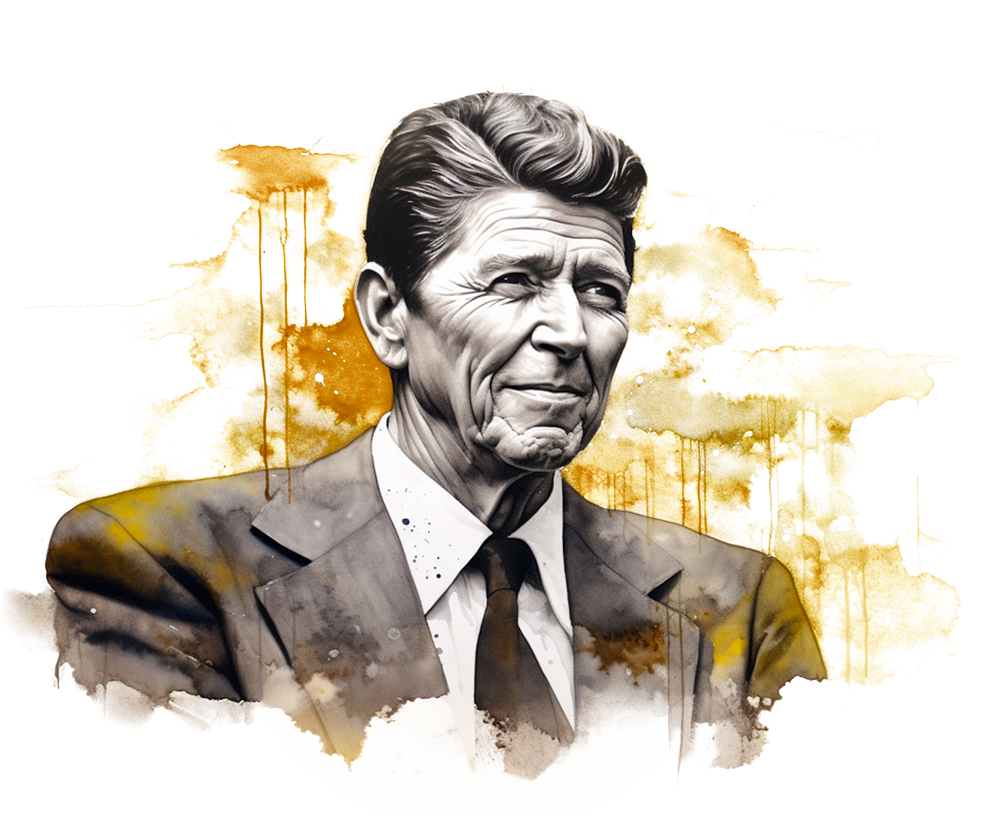Two days before his birthday in 1988, Reagan delivered remarks at the National Prayer Breakfast in Washington, DC. He told attendees that he had “long been unable to understand the atheist in this world of so much beauty.” With a touch of mischief in his voice, he added: “I’ve had an unholy desire to invite some atheists to a dinner and then serve the most fabulous gourmet dinner that has ever been concocted, and — after dinner — ask them if they believe there was a cook.”
The audience responded with extended laughter and applause. It was Reagan’s riff on the age-old argument for intelligent design, the idea that the order and purposefulness of nature point to a designer. Just as a sculpture implies a sculptor — or, in Reagan’s telling, a gourmet meal implies a master cook — the elegant and functional features of nature imply a creator. …
Get a free digital booklet and read the rest of the story …

The theory of intelligent design holds that many features of the universe and life are best explained by an intelligent cause rather than blind mechanisms such as natural selection.
Some of the most important questions investigated by science — the origin of the universe, the life-friendly fine-tuning of the universe, the origin of life, the origin of animals, and the origin of human beings — are best answered by intelligent design.
The Top Five Evidences For Intelligent Design showcases scientific evidence that supports the theory from biology, cosmology, and physics.
Note
The form below may be blocked by your browser or ad blocker. If so, you can fill out the form directly here.
The Rest of the Story …
We are approaching President Ronald Reagan’s 113th birthday, falling next week on February 6. Two days before his birthday in 1988, Reagan delivered remarks at the National Prayer Breakfast in Washington, DC.
He told attendees that he had “long been unable to understand the atheist in this world of so much beauty.” With a touch of mischief in his voice, he added: “I’ve had an unholy desire to invite some atheists to a dinner and then serve the most fabulous gourmet dinner that has ever been concocted, and — after dinner — ask them if they believe there was a cook.”
The audience responded with extended laughter and applause.
It was Reagan’s riff on the age-old argument for intelligent design, the idea that the order and purposefulness of nature point to a designer. Just as a sculpture implies a sculptor — or, in Reagan’s telling, a gourmet meal implies a master cook — the elegant and functional features of nature imply a creator.
The basic argument goes back millennia and can be found among ancient Greeks, Romans, Jews, and Christians. But the argument has gained new power in recent years because of contemporary discoveries in physics, cosmology, chemistry, and biology.
The interesting thing is that Reagan’s argument for design wasn’t part of the prepared text for his remarks that morning. Nor was it included in any of the earlier drafts of his speech, including ones he marked up. Former congressman Dana Rohrabacher, the designated writer for the speech, told me that “Reagan himself added it. He was indeed the great communicator.”
It wasn’t the first time Reagan had offered an argument for intelligent design.
“Those Intricate, Perfect Ears”
One of his favorite passages from Whittaker Chambers’s autobiographical book Witness offered a similar argument that he liked to cite. In the passage, Chambers dates his break with Communism to the morning he observed his young daughter eating porridge: “My eye came to rest on the delicate convolutions of her ear — those intricate, perfect ears. The thought passed through my mind: ‘No, those ears were not created by any chance coming together of atoms in nature… They could have been created only by immense design’” (“Foreword in the Form of a Letter to My Children,” Witness).
In his own autobiography, Reagan shared his early fascination with how nature points beyond itself. At age five, his family rented a house in Galesburg, Illinois, and the attic contained “a huge collection of birds’ eggs and butterflies enclosed in glass cases.” Reagan recalled how he “escaped for hours at a time into the attic, marveling at the rich colors of the eggs and the intricate and fragile wings of the butterflies.” He said “the experience left me with a reverence for the handiwork of God that never left me” (Reagan, An American Life, Chapter 1).
The ultimate source of Reagan’s banquet argument for design remains unclear. The 1988 Prayer Breakfast appears to be the first time Reagan cited the story at a public function as President. A search of his official presidential papers yields no other previous examples.
Yet the roots of Reagan’s banquet story may have reached back a long way.
For decades, Reagan collected and preserved his favorite comments, stories, and jokes on notecards, which he would draw on in creating his public talks. Years after Reagan’s death, the notecards were rediscovered in a nondescript box stored at the Reagan Presidential Library. Inside the box was a special stack of cards tied with a rubber-band that contained his collection of one-liners (Douglas Brinkley, editor, The Notes: Ronald Reagan’s Private Collection of Stories and Wisdom, Introduction).
One of these cards contained the kernel of his gourmet banquet story: “Ask an atheist who’s just had a great meal if he believes there’s a cook” (The Notes, 202).
The original notecards aren’t currently open to researchers, and so it is hard to know when the notecard with this comment was created. It could have been anytime from his General Electric days through his White House years. However, it was certainly before the 1988 Prayer Breakfast — most likely, many years before.
So while the Prayer Breakfast may have been the first time Reagan as President publicly used this story about intelligent design, it was likely not the first time he had used it in his lifetime of public speaking.
Nor would it be the last. For some reason, during his final year in office, Reagan seemed to gain renewed enthusiasm for his old notecard argument for design, and he invoked it repeatedly.
He shared the argument twice at his summit in Moscow with Soviet leader Mikhail Gorbachev, once with staff at the American embassy in London, and finally in the summer of 1988 at a public speech to thousands of young people gathered in Washington, DC, for a student congress on evangelism.
But it was only in his private one-on-one meeting with Gorbachev in Moscow that Reagan would reveal a deeply private reason he remained so interested in the argument.
The Faith of a President
Today the Moscow Summit is often remembered as the place where President Reagan finally acknowledged that the Cold War was over.

After strolling in Red Square with Gorbachev, Reagan was asked whether he still considered the Soviet Union an “evil empire,” and he replied, “No… I was talking about another time, another era.”
Although the Cold War might be over, Reagan still had a final mission he wanted to accomplish in Moscow. It wasn’t just more arms control, or the promotion of capitalism, or even the advocacy of more political freedom.
It was getting the Soviet Union to open the door to belief in God.
On Saturday, May 28, the day before he arrived for the summit, Reagan wrote in his diary: “We discussed the 1st meeting tomorrow which will be a 1 on 1 — me & Gorby. I’m going to tackle him on religious freedom” (The Reagan Diaries, 612).
Many pundits over the years have been dismissive of Reagan’s religious faith, comparing it unfavorably to the more public faith of “born again” President Jimmy Carter. But thanks to the work of political scientist Paul Kengor and others, we now know that Reagan was not merely conventionally religious. He was devoutly so — and his belief in God was one of the key reasons he objected to the Soviet Union. Reagan thought its system of state-enforced atheism cut people off from the possibility of eternal happiness.
In his famous “evil empire” speech of 1983, Reagan declared, “let us pray for the salvation of all of those who live in that totalitarian darkness — pray they will discover the joy of knowing God.”
Reagan’s interest in the spiritual condition of people wasn’t just at the level of the nation.
On May 19, 1982, when the health of his father-in-law, Loyal Davis, was failing, Reagan wrote in his diary: “I want so much to speak to him about faith. He’s always been an Agnostic — now I think he knows fear for probably the 1st time in his life. I believe this is a moment when he should turn to God and I want so much to help him do that” (The Reagan Diaries, 85).
Reagan later wrote his father-in-law a long, heartfelt letter quoting John 3:16 and urging him to accept Christ. The text of the letter only came to light in 2018, when it was published for the first time in the Washington Post. Nancy Reagan seemed to think her husband’s intervention played a role in getting her father to seek out a hospital chaplainshortly before his death.
In 1988, Reagan was still bearing a burden for the spiritual condition of someone even closer to himself: his youngest son and namesake, Ron.
Today the younger Reagan’s atheism is well known. He likes to boast he is a “lifelong atheist, not afraid of burning in hell.” But Ron Reagan’s atheism wasn’t public knowledge while his father was President. It was a private heartache for the senior Reagan, who had been distressed when his son announced at age 12 that he wouldn’t go to church because he was an atheist. Over the years, President Reagan had many conversations with his son hoping he would come back to faith.
“He was worried that my life would be diminished if I didn’t accept Christ as my savior,” Ron says. “We’d argue at the dinner table all the time.” Ron adds, “I don’t think he was losing sleep over it.”
He might have been wrong about that.
At the Reagan family’s Thanksgiving gathering in 1985, after Ron began pressing his case for atheism, Reagan privately turned to his eldest son, Michael, and said: “Michael, I’ve been praying that Ron would accept Christ like you and I have” (Michael Reagan, Lessons My Father Taught Me, Chapter 12).
Three years later, at the Moscow Summit, it would turn out that Ron’s eternal destiny was still on his father’s mind.
Mission to Moscow
Reagan arrived in Moscow on Sunday, May 29, and he held his first one-on-one meeting with Gorbachev that afternoon. The two men met in St. Catherine’s Hall inside the Kremlin.
While we don’t have a verbatim transcript of the conversation, we do have the confidential notes taken by the American notetaker, and I will be quoting from those notes to describe what happened.
According to the notetaker, Reagan told Gorbachev “he wished to take up another topic that had been a kind of personal dream of his. He had been reluctant to raise it with Gorbachev, but he was going to do it now anyway.”
Reagan was about to embark on what he called in his diary that night “my favorite pitch — why he should give his people religious freedom” (The Reagan Diaries, 613).
As the conversation unfolded, Reagan urged Gorbachev to grant full religious liberty to everyone in the Soviet Union — not just members of the Russian Orthodox Church, but to Moslems, Jews, Protestants, and Ukrainian Catholics.
Gorbachev was put off balance by the discussion. Initially insisting that the Soviet Union already guaranteed religious liberty, he tried to turn tables on Reagan by asking the President “why non-believers in the U.S. sometimes felt suppressed. He asked why non-believers did not have the same rights as believers.”
Reagan replied “they did,” and revealed his own secret heartache to Gorbachev: “He had a son who was an atheist, though he called himself an agnostic.”
Gorbachev finally conceded to Reagan that the Soviet Union may have engaged in “certain excesses” in its treatment of religion in the past.
But now things were getting better, he said, and he pledged that when Soviets like himself “spoke of perestroika, that meant change, a democratic expansion of democratic procedures, of rights, of making them real; and that referred to religion, too.”
Reagan could have considered this a victory and called it a day. But he kept pressing. He “invited Gorbachev to look at religious rights under our Constitution,” which even included the right not to fight in the armed forces if you were a conscientious objector. Reagan told Gorbachev that if he would do what Reagan asked, he “would be a hero and… much of the feeling against his country would disappear like water in hot sun.”
Reagan then recounted to Gorbachev a moving story he had told in his Prayer Breakfast speech the previous February. It demonstrated man’s yearning for God, and it even touched on the evidence of design in nature.
Reagan “said he had a letter from the widow of a young World War II soldier. He was lying in a shell hole at midnight, awaiting an order to attack. He had never been a believer, because he had been told God did not exist.” But when the young soldier looked up at the stars, he knew he had been wrong.
Because we only have notes summarizing what Reagan told Gorbachev, we don’t know how much detail Reagan shared with the Communist Party General Secretary about why the soldier changed his mind. But when he told the story at the Prayer Breakfast, he quoted the young soldier’s letter directly, which made things crystal clear.
“I’ve never contemplated your creation,” wrote the soldier, “and yet tonight, gazing up out of my shell hole, I marveled at the shimmering stars above me and suddenly knew the cruelty of the lie [of atheism].”
Reagan told Gorbachev that the soldier “voiced a prayer hoping that, if he died in battle, God would accept him.” Reagan saved the punchline for last: The soldier who wrote the letter was not an American. He was Russian.
Gorbachev seemed to be at a loss at how to respond at this point, and after some more pro-forma comments, he tried to change the subject to the possibility of a joint Soviet-American mission to Mars. Gorbachev then tried to bring things to a close, telling Reagan “he was very pleased with this first discussion. It confirmed that the two leaders were still on friendly terms.”
For his part, Reagan wasn’t quite ready to let go.
Rather than conclude with inoffensive pleasantries, he decided to raise his story about the gourmet dinner!
But this time he told the story with a slight, yet important, twist.
On all the other occasions Reagan publicly shared the story in 1988, he always framed it as focusing on nameless, generic atheists.
Yet meeting privately with the world’s most powerful Communist, Reagan revealed that there was really one particular atheist he wanted to reach.
His son.
According to the notetaker, Reagan “concluded that there was one thing he had long yearned to do for his atheist son. He wanted to serve his son the perfect gourmet dinner, to have him enjoy the meal, and then to ask him if he believed there was a cook.” Reagan added that “he wondered how his son would answer.”
I don’t know whether Reagan ever posed the scenario to his son. If he did, Ron presumably rejected it. But Reagan’s heartfelt thought experiment had made an impact on another atheist.
According to the notetaker, “As the meeting ended, Gorbachev said that the only answer possible was ‘yes.’”
Acknowledgments: I am grateful to Otangelo Grasso for making me aware of Reagan’s argument for design. I also would like to thank the staff at the Reagan Presidential Library and Museum for providing me access to the folders in the Reagan archives pertaining to his 1988 National Prayer Breakfast speech.
Learn More about Intelligent Design
What Is Intelligent Design?
- October 18, 2021
- 4
Unmasking DNA’s Coder
- January 20, 2021
- 1
Not By Chance
- December 18, 2020
- 12
Intelligence: The X-Factor in Life
- March 11, 2020
- 1
A Positive, Testable Case for Intelligent Design
- March 30, 2017
- 18
